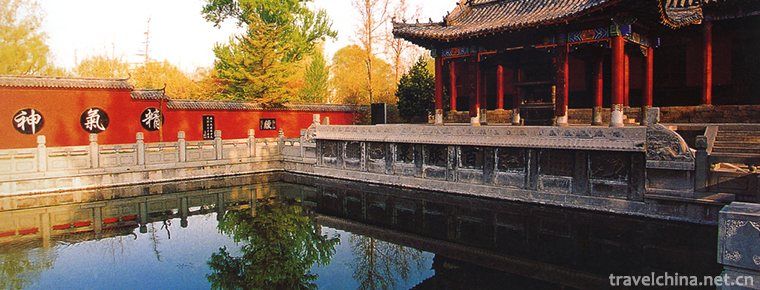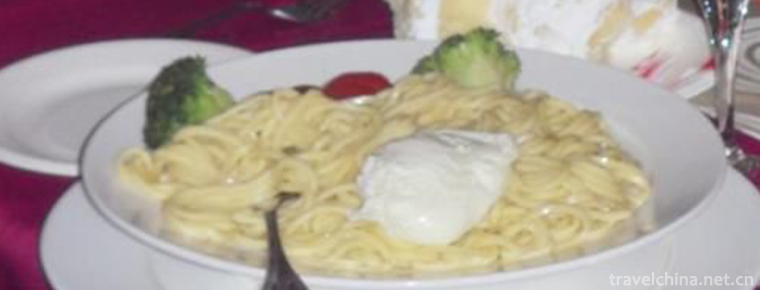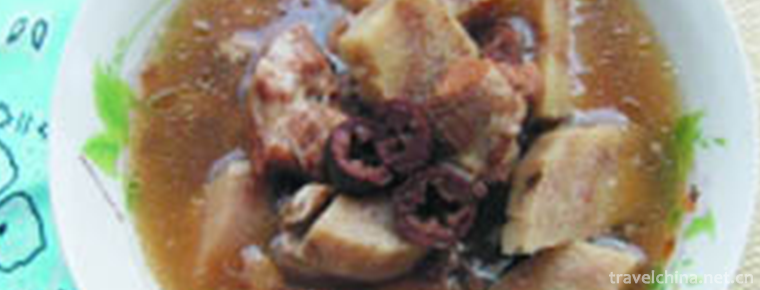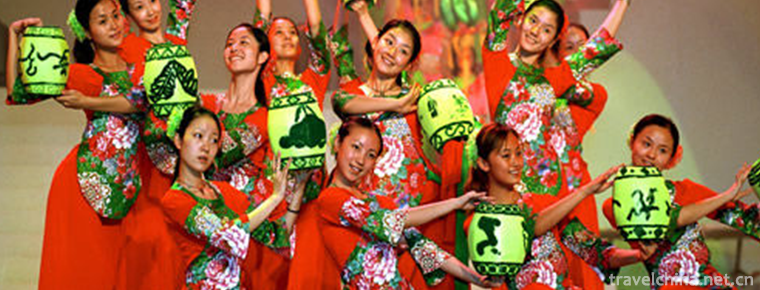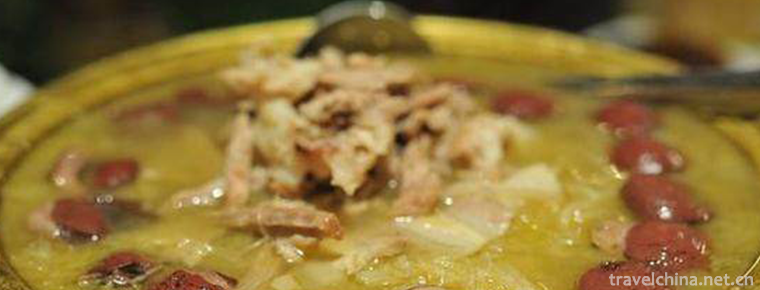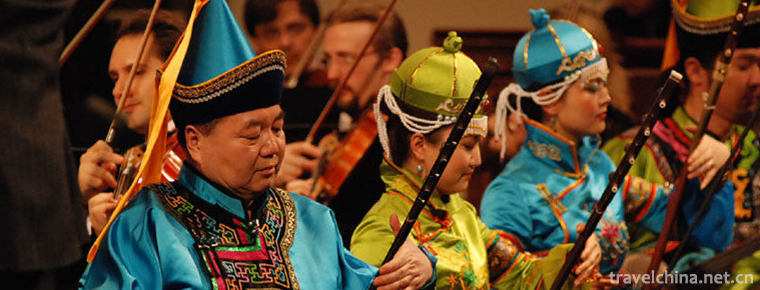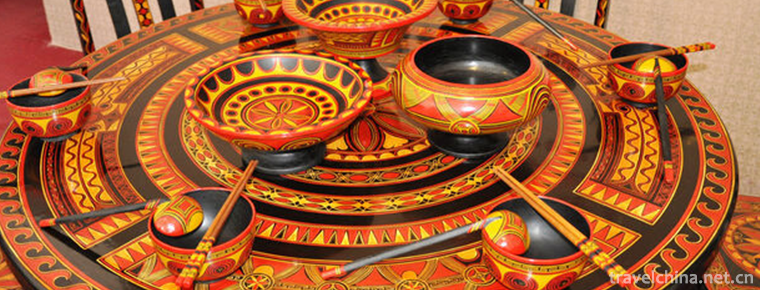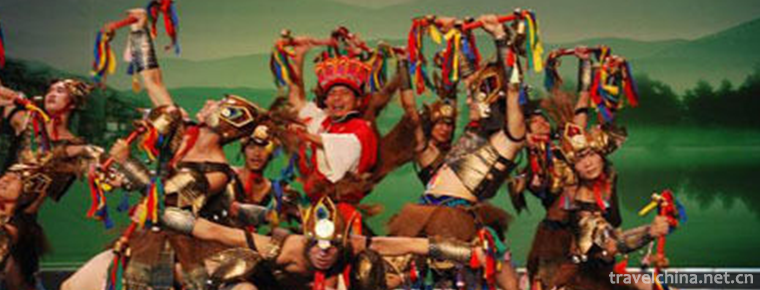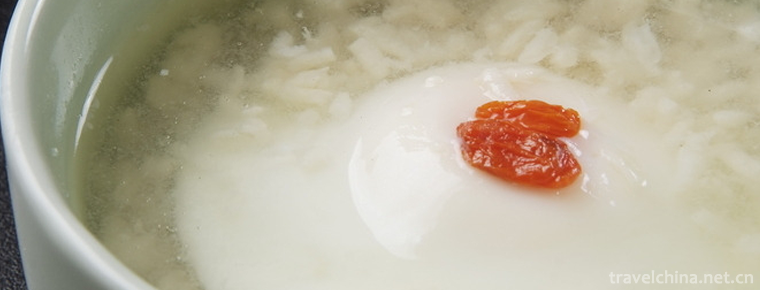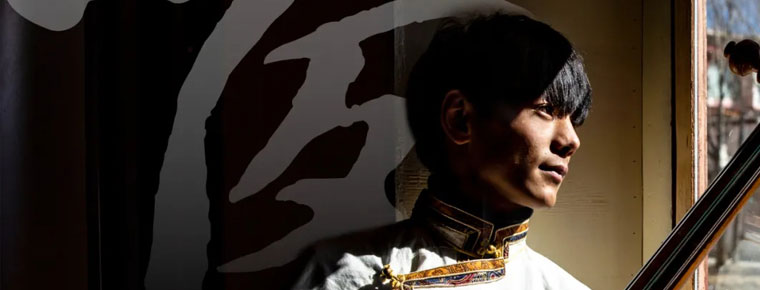Tibetan drama
Tibetan drama
The Tibetan name of Tibetan opera is "Aguiram", which means "fairy sisters". According to legend, Tibetan opera was first performed by seven sisters. The content of the opera is mostly the mythological stories in Buddhist scriptures, so it got its name.
Tibetan opera originated from Tibetan religious art in the 8th century. In the 17th century, it was separated from the religious rites of monasteries, and gradually formed a life-like performance, which was mainly composed of singing, chanting, dancing, watch, white and skill.
Tibetan opera has a high and vigorous singing voice, which is basically determined by people. Every singing voice has a voice help and harmony.
On May 20, 2006, Tibetan opera was approved by the State Council to be included in one of the first national intangible cultural heritage lists.
Noun interpretation
Tibetan opera is the general name of Tibetan opera. Tibetan opera is a very large opera system. Because of the differences in natural conditions, living customs, cultural traditions and dialect pronunciation, Tibetan opera has a large number of artistic varieties and schools. Tibetan opera originated about 600 years ago, more than 400 years earlier than Peking Opera, known as the quintessence of the nation, and is known as the "living fossil" of Tibetan culture. Tibetan opera is the mother of Tibetan opera art. It broadcasts Tibetan-speaking areas in Qinghai, Gansu, Sichuan and Yunnan provinces through monks and pilgrims who come to the Tibetan Zong Temple for further study, forming branches of Huangnan Tibetan opera in Qinghai, Gannan Tibetan opera in Gansu and Seda Tibetan opera in Sichuan. Tibetan operas are also popular in Tibetan settlements in India, Bhutan and other countries.
There are many kinds of Tibetan operas, but the mainstream is the Blue Mask Tibetan opera. The performance is generally divided into three parts, the first part is "Dun", mainly the opening performance of sacrificial songs and dances; the second part is "Xiong", mainly performing the legend of the main drama; the third part is called "Zaxi", meaning to bless Yingxiang. Tibetan opera has only one set of costumes from beginning to end. Actors don't wear makeup, but mainly wear masks to perform. Tibetan opera can be divided into white mask opera and blue mask opera. Blue Mask Opera has formed four major schools of Tibetan Opera: Jue Mu Long Tibetan Opera, Jue Ba Tibetan Opera, Shang Ba Tibetan Opera and Jiangar Tibetan Opera because of different regions.
Gannan Tibetan Opera is called "Nanmute" in Tibetan, which means "biography". Also known as "Labrang Tibetan Opera" because of its first performance in Labrang Temple, it evolved from Tibetan folk dances, folk songs and monk songs.
Historical development
Folk song and dance
Early Tibetan folk songs and dances have begun to appear with dramatic artistic forms. Some Tibetan historical materials have also been recorded in this regard. For example, there is such a record in "Tibetan King Tongji": Songzan Ganbu held a celebration meeting when he issued the Ten Good Codes, "to wear masks, dance and sing, or decorate a cow, or a lion or a tiger, inspire man to dance and perform skills in turn. Playing big drums, playing pipa, beating Rao cymbals, orchestral music, such as beautiful as you like, sixteen girls, beautiful decoration, holding flowers, singing and dancing, enjoying heartily, racing horses, Supreme drums, and beating closely"; the form of folk dance is also recorded in Sangji Jiatuo's Tibetan medicine book Aser;"At the completion ceremony of Sangye Temple, the ministers and people carried out'Zhuo'and'Lu'. ’ "Harmony" and other literary and artistic activities. "Zhuo" is the inspiration of wearing masks; "Lu" is only singing but not dancing; "Harmony" is both singing and dancing. At that time, the actors were all monks, sometimes accompanied by chanting sutras, which formed a new form of mime divine dancing and praying for Buddha. This form of performance can still be seen in Harugang Village, Naidong County. There is also the ancient large-scale inspiration team organization "Azhuo", whose leader's mask is roughly the same as the white goat skin mask in the early Tibetan opera, and the name of the masker is also called "Arova".
Folk rap
As early as the Ben religion period in Tibet, oral myths and historical legends known as "Zhong" had become an important part of Tibetan ideology at that time. There are storytellers and singers specializing in rap and singing in Ben religion. In Tibetan history, a large number of folk stories have been produced in past dynasties. These stories are sung out in the form of folk songs, praises, rhymes and so on, which makes the stories more vivid and moving. This form of singing has been continuously developed and improved in the long process of circulation. This is also one of the reasons why many folktales have been circulated so far. For example, the Tibetan folk heroic epic King Gesar, which originated in the eleventh to thirteenth centuries, was influenced and developed by Buddhist rap literature. In addition to monologue and dialogue, the narrative of some stories was also changed to the rhyme of singing, and the rhyme was written in the form of folk songs.
In addition, other forms of rap and singing, such as "folding ga" (meaning auspicious wishes), and "Lama Ne", also played an important role in promoting the production of Tibetan opera. Especially the rap art of "Lama Ne", which has a great influence on Tibetan opera, the script of Tibetan opera is the script of the rap story of Lama Ne artists. The characteristics of rap art are also clearly reflected in Tibetan opera performance. If there is a narrator in Tibetan opera performance, the actor will sing wherever he talks; the narrator can only perform after introducing the narrator with a fixed recitation.
Religious rites
Tibetan history "Baxie" records: "In the eighth century, when Tubo Zanpu Chisong Dezan built Sangye Temple, Master Lotus and Peanut took the lead in using a dance in the ritual to accommodate evil spirits." This kind of dance is the origin of the Tibetan Buddhist Temple dance God "Dojiga Qiang Mu" (Diamond Dance, referred to as Qiang Mu). Qiang Mu is a new religious ritual dance evolved from folk folk folk dance on the basis of the primitive benzoic wizards'ritual of sacrificing natural gods. At first, Qiang Mu performed for monks in monasteries. Later, it was introduced into the folk. All monks and laymen could watch it. It gradually became a kind of religious dance with certain entertainment which was popular among monks and laymen. In addition, Linzhi also has a kind of "Minaqiang Mu" (the common people jump gods), which is totally unrelated to the temple. It is a folk sacrificial dance created to bring back "village treasures" for exorcising evil spirits and welcoming good fortune. Among them, the male servant God dance, which symbolizes festivity, luck and auspiciousness, was also absorbed by the temple God Sakya temple Zhuomapo Chapter "Zimadoga" Qiang Mu and Tibetan opera "Baimawenba".
By the 14th century, Tang Dongjibu (1385-1464), a prominent monk of the Gaju sect (Bai religion), presided over the construction of the first cable bridge in Tibet in 1430 on his journey to the clouds. During the construction of the bridge, he found seven sisters (seven brothers and sisters) who were good at singing and dancing. On the basis of the white mask drama, he absorbed the dramatic elements of the Buddhist Sutra legends and folklore stories to arrange performance programs, design singing movements and accompaniment of cymbals, and guide the seven sisters to perform, so as to propagate religion and raise funds for practicing good deeds and building bridges. Seven sisters are naturally beautiful, dancing gracefully and singing beautifully. The viewers think that the fairy goes down to earth and praise it as "Ajiram" (fairy). Later, Tibetan opera was called "Aguiram", which was also named after it. According to the biography of Tang Dongjiebu, the number of iron bridges and wooden bridges built by Tang Dongjiebu is up to hundreds, and there are more than 100 ferry terminals. To build so many bridges and ferries, the funds needed are mainly raised by organizing donation performances, besides the lobbying income. Later, Tang Dongjibu took the white mask drama developed by him back to the main temple of his hometown, Ji Riwuqi Temple, and created the Ji Riwuqi Opera Troupe. The white goat skin mask was decorated and changed into a blue mask. On the basis of the performing art of the white mask drama, he compiled the Buddhist Sutra story Zhimei Gengden, combining various local singing and dancing, ancient yoga skills and acrobatics. From then on, Blue Mask Opera gradually formed.
With the establishment of the local regime in Gadan Pozhang, Tibetan opera, especially Blue Mask Opera, has entered a period of rapid development and prosperity. The art form of opera performance, which mainly focuses on singing, chanting, dancing and expressing, has been formed. Opera literary plays with high literary level and a number of excellent traditional plays have emerged. In the folk, some professional or semi-professional Tibetan opera troupes began to appear, and different artistic schools began to form in artistic style. By the seventh Dalai Lama, there was a grand performance of Tibetan opera, Shelton Festival. During this period, the fifth Dalai Lama, Rosan Jiacao (1617-1682), contributed a lot to the development of Tibetan opera. In the ninth year of the Qing Dynasty (1652), the fifth Dalai Lama led 3000 people to Beijing and Jin to see the emperor Shunzhi. For the first time in history, he was sealed by the central government as the "Dalai Lama" with a gold seal. The fifth Dalai Lama stayed in Beijing for two months during his visit, and then in Daiga (now Liangcheng) of Inner Mongolia for three months. During these five months, the fifth Dalai Lama saw many court and folk music, dance, drama, acrobatics, hundred arts and other artistic performances of Han, Mongolian and Manchu nationalities, and was deeply inspired. After returning to Tibet, the western-style singing and dancing introduced from Ladak will be transformed, and the only official professional singing and dancing team of Tibetan local government, Garba, will be organized and established. The fifth Dalai Lama also liked Tibetan opera very much. When he was not in charge of his own government, he instructed and advocated the monastery to hold a yoghurt banquet at the end of the last summer residence practice. He invited some well-known Tibetan opera troupes to perform in Zhepeng Monastery, which initiated the practice of "Zhepeng Xueton" tuning and watching Tibetan opera.
Later, it gradually formed in Zhepeng Temple, followed by "Jicai Luoding" (Happy Garden), and finally held an annual grand Tibetan opera performance in Roblinka during the Shelton Festival. The fifth Dalai Lama also instructed his hometown, the white mask troupe of Qiongjie County, to be divided into two classes, one is Qiongjie Xibington, the other is Pennaro Pinching Bington, and to arrange the first performance of Qiongjie Xibington during the Shelton Festival in Lhasa. During this period, Tibetan opera scripts specially adapted, processed and recorded as scripts or engraved scripts appeared among the local people. In many places and some of the Seqin temples, Tibetan opera classes with relatively fixed and professional nature were also set up. Every year, there are at least a few white mask troupes and many performing groups such as Jiangar, Xirong Zhongzi and Gongbu Zhuoba participating in "Zhebeng Shelton". From this time on, Tibetan opera began to separate from religious ceremonies and become an independent theatrical art form; actors gradually separated from monasteries, and professional performing troupes began to appear. In the course of its development and evolution, Tibetan opera has gradually expanded its influence. It has multiplied many kinds of operas, such as Dege opera, Changdu opera and Menba opera, and has exerted a great influence on the formation and development of some brotherly ethnic operas.
Formation and dissemination
After continuous development and improvement, Tibetan opera has formed its own set of systematic and complete art forms after the 17th century, which is called a unique type of Chinese opera, and has been widely spread in Tibetan areas, and is deeply loved by Tibetan compatriots. In the course of spreading for hundreds of years, many traditional operas have appeared successively, and the eight famous Tibetan operas have been playing for a long time. The performances of various plays vary from a few hours to several days, but each play can generally be divided into three parts: the prologue, the main play and the farewell ceremony.
Due to the differences in environmental conditions in different regions, Tibetan opera has gradually formed a variety of schools, mainly the white mask school belonging to the old school and the blue mask school belonging to the new school, as well as the monologue opera. At present, the blue mask school has the greatest influence. Wearing masks as actors'facial makeup is a major feature of Tibetan opera. However, as one of the schools of Tibetan opera, most of the Anduo Tibetan opera troupes in southern Qinghai changed to apply oil directly to make-up on their faces, and combined singing, white and dancing more closely to enhance the dramatic effect.
Before liberation, every Shelton Festival, Tibetan opera troupes from all over the country needed to travel to Lhasa to perform performances for Dalai Lama and local government officials. These poor Tibetan opera troupes have become the backbone of amateur theatres all over the country. Because of the differences in history, geography, language, style and attainments, theatres in different regions have formed different schools of styles.
Among these schools, there are white masks belonging to the old school, new ones belonging to the blue mask, and one-legged plays.
It belongs to the old school of white mask. There are pentongba, Longzewa of Duilong Deqing, Zhaxi Xueba in the east, and so on. Because the old school wore a white mask, it was called a white mask. Their acting and singing are relatively simple and less influential.
The new school is the four major theatre troupes of Kumba, Jianggar, Jue Mulong and Shamba. At the beginning of their performance, the performers wearing blue masks appeared, so they are called blue masks. The performance art of the new school has developed greatly, and its influence is greater. Slowly, the old school has been replaced.
Improvement
After the peaceful liberation of Tibet, the government of the autonomous region established the Tibetan Opera Troupe in Yuanjue Mulong on the basis of the Tibetan Opera Troupe. It undertook the task of inheriting and developing Tibetan Opera. It arranged and performed a number of traditional operas such as Longsa Wenbeng, Princess Wencheng and Prince Nuosan. At the same time, it also created and performed some modern themes. The troupe maintained the original artistic features of Tibetan Opera square. On the basis of color, the practice of theater stage art was carried out, which enabled Tibetan opera to step onto the stage from the square, with lighting, scenery and make-up, and began to use orchestral accompaniment.
After the 1980s, Qinghai Tibetan Opera Troupe was founded in Huangnan. It has created and performed excellent plays such as "Yile Fairy", "Envoy of the King of Tibet", "Golden Dawn" and so on, which has exerted a great influence at home and abroad. The new repertoire has brought new vitality to Huangnan Tibetan opera, such as the accompaniment of "Yile Fairy", which includes traditional Tibetan instruments such as six strings, and large modern mixed bands mainly composed of folk music. While forming interluded atmosphere music, it can directly accompany the singing tune, changing the Tibetan opera's style of using drums and cymbals only to press the rhythm of dancing and performing movements, and rarely accompanying the singing tune. Condition. The improved scenery and stage art of Huangnan Tibetan Opera are magnificent, magical and elegant, and refreshing.
Legend
Text of Tibetan Opera
How many other plays in the world are performed in masks?
How many other plays in the world do not have a stage at the time of performance?
How many other kinds of plays in the world can a play last for three or five days?
Let's start with the legendary story of Tang Dongjieb, a Tibetan monk.
At that time, there were no bridges on the Yarlung Zangbo River, many leather boats were capsized in the torrent, and many people who wanted to cross the river were swallowed up by the roaring water. So Tang Dongjiebu, a young monk, made a great wish and vowed to build a bridge for the benefit of the people. Tang Dongjieb, who had nothing but a burst of laughter.
So there is such a legend. Tang Dongjiebu met seven girls who could sing and dance in Qiongjie, Shannan. He formed the first Tibetan Opera Troupe in Tibet. He performed religious stories and historical legends in the form of singing and dancing. He encouraged people to do good deeds, contribute money and build bridges together. With the vigorous song ringing through the snow mountain wilderness, some people give money, some people spread iron, some people bring food, and a large number of farmers, craftsmen follow them, from one bridge construction site to another bridge construction site...
The seeds of Tibetan opera were then sprinkled all over the snow plateau. Wherever they went, people were amazed at the beautiful looks, graceful dancing and beautiful and fresh singing of the girls. The audience exclaimed, "It's not Aguiram dancing down to earth!" Later people called Tibetan opera performance "Aguiram".
In this way, the penniless Tang Dongjiebu left 58 cable bridges on the Yarlung Zangbo River and became the founder of Tibetan opera.
In Tibetan opera, the masks worn by people of the same identity are basically the same in color and shape.
The mask of the good is white, white represents purity.
The king's mask is red, and red represents majesty.
The princess's mask is green, green represents softness;
The mask of the living Buddha is yellow, and yellow represents auspiciousness.
The witch's mask is half black and half white, which symbolizes her character of two sides and three knives.
The face of the devil is blue and tusks, to show repression and terror.
The old villagers'masks were sewn with white or yellow cloth, and a hole was dug in their eyes and lips to show their simplicity and honesty.
Masks use symbolic and exaggerated means to make the characters in the drama outstanding and distinctive, which is one of the important reasons for the preservation of Tibetan opera masks in the long-term development process.
Snow mountain rivers and grasslands are the backgrounds. The artists of Tibetan opera sing on the floor, without curtain, lighting, props, as long as a drum, a cymbal accompaniment. They have nothing to ask for, as long as they have an audience.
The audience gathered around, and all the plots were described by the explanation of "Xiong Xieba" and the rap of artists. The artists sang, talked and danced, deducing various stories under the mask.
In the development of hundreds of years, Tibetan opera has formed its own fixed formula: opening Chen Shuo Tibetan opera history to attract audiences, the main part of the main drama performance story, ending with the intention of celebrating the success of the performance.
Tibetan opera artists'singing and movements are rich and varied. Different characters sing with different singing tunes, different emotions have different dance movements to express, different genres, different theatres have different styles of performance. It is not surprising that the audience watches a play for three or five days while eating, drinking and playing. Everyone is free to swim and tirelessly.
This is how Tibetan opera is taught from generation to generation.
(The article is selected from Lesson 7, Tibetan Opera, Volume 6, Primary School Chinese Publishing Press)
Understanding of Sentences
How many other plays in the world are performed in masks?
Experience: The method of expression in the beginning of the text is novel and unique. It uses rhetorical questions to prevail and emphasizes the prominent features of Tibetan opera in masked performances. At the beginning of the three consecutive counter-questions, the author emphasizes the three characteristics of Tibetan opera and lays down a foreshadowing for the following specific features of Tibetan opera.
(2) Let's start with the legendary story of Tang Dongjieb, a Tibetan monk.
Experience: This sentence plays a connecting role in the layout of the full text. The first part summarizes the three characteristics of Tibetan opera, and introduces the legendary stories of Tang Dongjiebu and the formation of Tibetan opera with "or" turning point. Tang Dongjiebu is the founder and originator of Tibetan opera. Without Tang Dongjiebu, there would be no Tibetan opera. Senior monks: monks (monks) with high moral standing. Legendary Stories: Stories that are extraordinary in plot or character behavior.
At that time, there were no bridges on the Yarlung Zangbo River, and innumerable Kraft boats were capsized in wild horses'runaway torrents. Many people who tried to cross the river were swallowed up by the roaring river.
Experience: With concise and accurate language and vivid image, the author reproduced the harsh natural environment at that time, indirectly praised the noble quality of Tang Dongjieb, and explained the ideological root of his great wish and vow to build bridges.
(4) Masks use symbolic and exaggerated methods to make the characters in the drama prominent and distinctive.
Experience: Why do Tibetan opera masks remain in the long-term development process? This sentence gives a precise answer. The causal relationship between the front and back parts of the sentence is that "using symbolic and exaggerated methods" is the reason, while "outstanding characters and distinct personality" is the result. Symbolic means: Expressing a particular meaning or feeling with specific things. For example, in Tibetan opera, white masks are used to represent purity, while those who wear white masks are good people and good people. Exaggeration: In order to inspire the audience's imagination, use exaggerated things to express. For example, in Tibetan opera, the half-black and half-white mask is used to describe the character of two sides and three knives, and the mask of the green face and tusks is used to describe the devil.
Interpretation of Words
Plays: The types of theatrical art. Example: There are many kinds of folk operas in China.
Roaring: Describes the rushing and roaring of the current, and the furious shouting of people. Example: The flood roared and rushed toward the shore.
Running off the reins: The original meaning is that the horse breaks away from the reins, but now it has the meaning of breaking away from some kind of bondage.
Devotion: Devotion: Bite. Devour. Example: The snow devoured everything, and nothing was visible.
Vigorous: This lesson refers to the song is magnificent and vigorous. Ex: Vigorous singing came from the auditorium.
Living Buddha: This lesson refers to the upper lamas who succeeded by reincarnation system in Lamaism.
Witch: A woman whose profession is to pretend to be a God or a ghost and pray for others.
Repression: Restrict emotions, strength, etc., so that they cannot be fully exposed and brought into play. Example: He tried to suppress his feelings and keep his tears from flowing.
Dunhu: loyalty. Example: Dunhua honest Xiao Wang did not say a word.
Deduction: A method of reasoning in which conclusions about special situations are derived from general principles. This lesson can be understood by acting and expressing. Example: Scientists have deduced the changes of the earth in the next few hundred million years and believe that the earth will not disappear.
Solicitation: solicitation. This lesson refers to the opening of Tibetan opera to attract audiences by presenting the history of Tibetan opera.
You Yo: You: beautiful, comfortable; Yo: mood word, expressing exclamation.
Originator: Kaishan: Buddhist term refers to the first establishment of a temple in a famous mountain. Ancestor: A metaphor for the founder. Originally refers to the founder of a cause. This lesson refers to Tang Dongjiebu as the founder of Tibetan Opera.
Two sides and three knives: metaphor is sinister and cunning, face to face and back to face.
Whatever you want: Whatever you want: Whatever you want; Desire, Want, Hope. You can do what you want in your heart. Listen to your heart.
Artistic characteristics
Form of performance
The performance of Tibetan opera is divided into three parts: the opening ceremony drama "Arova", the main drama "Xiong" and the auspicious ending ceremony "Zaxi". The opening ceremony, also known as "Winbaton" or "Jialu Wenba", is mainly about pure-court sacrifice, praying for gods to exorcise evil spirits, praying for blessings, and introducing the plot. Generally speaking, there are two people in Jialu, seven in Wenba and seven in Lam. Legend has it that these three characters evolved from the characters in the play Qujie Lausanne. Jialu is the prince, Wenba is the fisherman or hunter, Ram is the fairy. The performances started with Winba singing and dancing in a mask, and then Jialu led a group of fairies to sing and dance to introduce the actors, explain the plot of the main play and attract the audience. "Xiong" is the main drama. First, "Weinbaggeng" (that is, the actor) introduces the plot, location, environment, character modeling, lyrics and so on with fast-paced rhymes, and then the characters appear. The duration of the performance is three days, three nights, or even six or seven days; the duration of the performance is two or three hours, which is controlled by the theatre.
Its form of performance is: all actors, whether or not they play the role in the play, all appear in half circle, when it is their turn to perform, that is, to perform in a list, the rest of the time to participate in accompaniment and dance. Its basic performance format is: first, the actor introduces a plot, then sings a part out of a role, and then all the actors dance together or perform skills, according to this cycle. Its performances are not divided into acts and performances, and the narrator of the plot and the accompanying singer and dancer actually play the role of dividing the acts. Because traditional plays are generally classics that have been circulated for hundreds of years, or even centuries, most audiences are familiar with the characters and plots of the plays. They watch performances mainly to appreciate the singing, dancing and special skills in the play. Because the plot development is introduced by the actor, the characters in the play can concentrate on singing or performing stunts. Through the clever arrangement of the performers, a beautiful story, beautiful singing, stunt performances exciting, and the beautiful art form of accompanying dancing with the voice of the same performers is displayed in front of the audience. "Zhaxi" is a collective dance at the end of Tibetan opera performance, which means good luck.
Sing (Rhonda):
The main content of Tibetan local ethnic operas is to sing biographies of various characters. In order to distinguish between songs and operas, people used to call opera singing "Rhonda" (meaning biography). Tibetan opera has a high and loud singing voice, all of which are free rhythm slabs. The use of aria is mainly determined by the identity of the characters in the play, and the monologue is exclusive and can not be borrowed casually. Tibetan opera singing mainly includes: long tune , middle tune , short tune , sad tune , song opera mixed chamber , rap mixture chamber [harmonic horse wood]. Generally, each aria can only sing two sentences of seven to nine characters, and the maximum number of words in an individual aria should not exceed thirteen. The number of words and sentences on the numeral board is not limited.
Dance (Xiaozhuo):
Tibetan opera is basically square opera, singing and dancing is the prominent feature of Tibetan opera. Dance is often not directly related to the plot, mainly to foil the atmosphere of the performance on the floor. Only a few movements in dance have some symbolic meanings and imitate the movements of labor, life and animals.
Rhyme (Xiongxieba):
It is a kind of rhyme similar to Allegro and Number Board. It is mainly used in situations where the narrator reads the story and introduces the actors to perform.
White (give card):
In Tibetan opera, oral vernacular was seldom used in the past. Even though it was mainly used by comedian characters, it has been appropriately increased in order to enrich the means of performance and facilitate the audience to understand the plot in future performances.
Table (Longju):
A performance. The Performing Arts in Tibetan opera are simple and simple. Many characters perform in masks, so actors pay little attention to the expression of facial expressions, and there is less communication between the roles.
Techniques (Lv Ze):
It refers to the dancing skills and martial arts skills in Tibetan operas. This part of the performance elements are mostly absorbed from folk art forms.
Harmony:
It refers to the performances of folk songs and dances. It is a unique form of performance formed by the combination of folk dance and Tibetan opera, singing and cymbal rhythm. But it has nothing to do with the plot.
The costumes of Tibetan operas are very simple. The performances are only one set from beginning to end, and there is no change in the middle. Actors usually don't wear makeup, but mainly rely on masks. Before the peaceful liberation of Tibet, Tibetan opera performances often smeared bamboo noodles or pot smoke on the faces of the underprivileged working people. After the peaceful liberation of Tibet, especially after the establishment of the Tibetan Opera Troupe in the autonomous region, many attempts have been made in the aspect of character modeling, such as moving the pattern on the mask directly to the face to become a kind of facial makeup, or making up by comparing the figures on the murals, and sometimes using the disguise method of the drama. But the traditional character masks of Tibetan opera itself remain.
Tibetan opera has gradually formed a relatively fixed program in its performance practice for hundreds of years.
The performances of Tibetan operas are usually square operas, and a few of them also have stage performances. When performing, make-up is relatively simple, besides wearing masks, the other is general flour and red fat, there is no complex facial makeup.
Instruments are also simpler. Percussion music has only one drum and one cymbal. During the performance, one person used a fastboard to introduce the development of the plot to the audience. There are few humanistic words in the play. The performers concentrate on singing. Because of the square performance, the performers'singing voice is very high and bright, and there are many dragging tones, which shows their rugged and powerful character. Backstage usually has a helpful voice, the form is similar to Sichuan Opera.
Tibetan opera has many singing tunes, which can be roughly divided into long tunes expressing joy, called "Jue Ren" in Tibetan, sad tunes expressing pain and sorrow, called "Jue Lu" in Tibetan, short tunes expressing narration, and "Party unity" in Tibetan, etc.
Aria role
Before Tibet's democratic reform in 1959, Rhonda (opera aria) in Tibetan opera was basically unaccompanied solo. Even in the performance of singing and dancing, it was accompanied by two percussion instruments, cymbals and drums. Drum and cymbal ideas are an important part of Tibetan local opera music. It is mainly used for accompaniment of various dances and performances. At the same time, it also plays the role of describing the environment, cohesive singing and unified rhythm. Drum and cymbal ideas are mostly absorbed and developed from the oldest Tibetan folk "buffalo dance", "lion dance", "inspiration" and large-scale traditional folk song and dance "Jia harmonious", as well as the Tibetan primitive anti-disaster song and dance "Jidajimin" and other drum and cymbal ideas. Like Rhonda, it is also used for setting music and monologues. Especially in traditional plays, every character has cymbal ideas reflecting his personality. Drum and cymbal ideas originated from various folk arts, but in the long-term development process, due to the needs of opera performance, they have evolved into a set of playing methods with opera characteristics different from the folk drum and cymbal ideas. There are obvious differences in the specific percussion and the change of the ideas of cymbals and drums in various operas. It is this distinction that makes it one of the symbols for Tibetan audiences to distinguish different kinds of Tibetan drama. They can judge what is going on there by the beating of cymbals and drums from different directions.
Classification of roles: There is no division of roles in Tibetan opera. There are only story tellers, performers, comedians, blessers, accompaniments and dancers in the opera troupe, which has not yet formed a complete system of roles. But in the long-term performance practice, with the increase of large-scale repertoire performances, various types of roles have gradually formed, such as thirteen of the most abundant bluemask plays in artistic development. These role types are:
Young men
Equivalent to a pupil, playing a young king, prince or noble youth. Such as Songzan Ganbu in Princess Wencheng.
Male elderly
Play the roles of the old king, minister, elder man and so on. The performance requires stability and dignity. For example, Nochin, the old king in King Northumpha, and Chachin, the foreman in Longsa Wenbeng.
Male supporting role
Act as a male servant, or as an ornamental king, king, minister, etc. They usually have very few plays.
Young women
Play fairies or empty mothers, peasant girls, deer girls, ladies, princesses and other characters. Such as Suginima, the deer girl in Suginima, Yunzhuolam, the fairy in King Northumpha, etc.
Female elderly
Play the role of queen or mother. The performance of the duet requires stability, dignity and sophistication. For example, the queen Jiagalam in King Norsanfa and the mother Rafael in Baimawenba.
Supporting actress
Acting the roles of maid, concubine, companion and maid, except for some plays, it is basically a "dragon set" in the play, just as a foil, standing aside, without a line or a lyric.
Main clown
Act as the main negative characters who are criticized and denied, such as wizards, magicians, queens of demons and princesses. There are many plays in the play, such as repeating, figurines, dancing and expressing meritorious deeds. All the performances of this role need profound skills in interesting, humorous and humorous performances. For example, the wizard Hage in King Northumpha and the princess Hajiangdum in Zovasam.
Clown
Act as the housekeeper, minister, concubine and dancer under the villain's clown. Their plays are often heavy, and some even outweigh the main clown. Its acting skills are rich, its performance is comical and exaggerated, arbitrary and natural. Emphasis is placed on performing with exaggerated vernacular, rhyme and dancing body. Generally, there is a fixed set of skilled movements and acting routines.
Clown corner
Play the hawk dog, assistant, accomplice, fighter and so on under the villain clown. Plays are often associated with villain clowns and act together. Emphasis should be laid on the daily comic performances of Tao Bai and chanting, such as flattery to the superiors and hard-handed to the subordinates. Its portrayal and imitation of characters are vivid and accurate. Sometimes the performance leaves the plot, makes impromptu performance, or plays with the audience, or imitates, exaggerates, distorts the actor's performance action, in order to create comic effect.
Harlequin
It refers to the ordinary positive characters in the play. They often use comedy to show that the positive characters overcome the evil forces and show their intelligence and humorous character.
Interlude role
Characters that are occasionally interposed according to the plot. Although there are not many plays, they are necessary for the plot. For example, the fairy and the young fisherman in King Norsanfa.
Animal role
It refers to the fable, the incarnation of gods and Buddhas, spirits, etc.
Accompanying dancers
It refers to the Wemba, Jialu, Ram actors and other actors who do not play roles in the main play. They should always accompany and dance for the leading role in the whole play.
Explaining roles
This is a unique role in Tibetan opera, usually played by theatre performers. Play the first Wemba or the first Jialu in the opening play; also often play the main role in the main play. The character commands the whole performance with a fast-paced rhyme-and-white recitation stunt.
Mask
It is mainly used for various folk performances. Compared with religious masks, Tibetan opera masks have strong secular tendency and folk color. The themes of expression mainly include characters, gods and animals in historical stories and myths. Different mask colors symbolize different character characteristics, such as deep red symbolizing king, light red symbolizing minister, yellow symbolizing living Buddha, blue symbolizing negative characters, and semi-black and semi-white symbolizing double-faced, etc.
In Tibetan opera performance, the general makeup is relatively simple, in addition to wearing masks, the other is the general flour and red fat, there is no complex facial makeup. From the shape and tone of the mask, we can distinguish the good, evil, loyalty and adultery of the characters. The face makeup of Tibetan opera performers is to draw a face mask on the face, and the other is to wear a mask. Masks, called "ba" in Tibetan, are unique facial makeup means in Tibetan opera art. As early as in the Tubo period, masks were used in the ritual ceremonies of Ben religion culture to perform various acrobatics such as scholar-wind dance and animal-like dance. Later, because of the development of religion, the eminent monk Lotus Peanut organized the divine dance congregation according to the Yoga Department and the Vajrayana Dance section of the Supreme Yoga Department (the other two are the Ministry of affairs and the Ministry of action) of Buddha Sakyamuni's four doctrines on Buddhist Tantricism.
Thus, the local wind dance combined with the Vajra dance, resulting in the mask worn when dancing God dance. In the 14th century, Tang Dongjiebu, a monk of Yunyou, raised funds for building bridges and roads, and created Tibetan operas that were popular with Tibetan people. Later, Tibetan opera performers regarded him as the ancestor of Tibetan opera, and made white goat skin masks with white hair and whiskers according to his own style. With the emergence of Tibetan opera masks, the ancient Tibetan mask art has entered a new and wider art world from the mysterious religious world.
Tibetan opera masks are divided into three types: Wenba masks, character masks and animal masks.
Mask color
The Mask of the Good: White (White stands for purity)
The King's Mask - Red (Red stands for majesty)
Princess's mask - green (green represents flexibility)
The Mask of Living Buddha: Yellow (Yellow represents auspiciousness)
The mask of the old villagers - white or yellow, eyes and mouth for a hole (on behalf of the simple and honest elderly villagers)
The witch's mask is half black and half white (symbolizing her character of two sides and three knives)
The mask of the devil - the green face and tusks (to show depression and terror)
white
White masks show the character's purity, kindness, gentleness, harmless heart, meaning that the elderly live a long life, while the white masks are unreasonable for the young.
Contrast: The white face in Peking Opera shows that the character is fraudulent and suspicious, and the representative is Cao Cao.
yellow
The yellow mask is a symbol of glorious appearance, vast merits and profound knowledge. It is worn by living Buddhas and fairies.
Contrast: In Peking Opera, the yellow face represents the strong personality of the characters, and the representative of the character Dingwei.
blue
The blue mask represents justice, bravery and bravery.
Contrast: The blue face in Peking Opera shows that the characters are upright and unruly. The representative is Dolton.
green
Green mask symbolizes virtue and wisdom; beautiful and dignified, a woman who belongs to the incarnation of Tara or empty girl.
Contrast: The green face in Peking Opera represents the character of brave and reckless. It is often used to show a good man in the green forest.
gules
The red mask symbolizes power, justice, resourcefulness and courage. Everyone who plays the role of king or minister wears a red mask. Sometimes in Tibetan operas, some men are angry and often red.
Contrast: The red face in Peking Opera symbolizes loyalty. Guan Yu is the representative.
black
Black masks are evil and angry.
Contrast: In Peking Opera, black face represents impartiality and selflessness. The representative is Bao Zheng.
Half white and half black
Half-white and half-black masks show sweetness and poison in the mouth, with two sides and three knives, which are specially used to provoke alienators.
Mask form
Door curtain mask: also known as curtain mask. The mask is made of a cut hole in the eye (which is easy to reveal the sight). The other parts are painted with graphic flat cloth. The face is suspended during the performance and the face makeup of the characters in the play is replaced by the face makeup. This kind of mask is mainly displayed in Huare Tibetan Opera at Zhugu Temple in Menyuan County, Haibei State (which was lost at the time of investigation). Although the shape of the door curtain mask is simple, in the description of the five senses, it focuses on describing the expression characteristics of the characters, and expresses the identity, status, personality and emotional characteristics of the characters in Qinghai Tibetan Opera with abstract and changeable lines and symbolic colors. It is a more flexible and convenient mask style in Qinghai Tibetan Opera.
Performance Kung Fu
Sing (Rhonda):
The main content of Tibetan local ethnic operas is to sing biographies of various characters. In order to distinguish between songs and operas, people used to call opera singing "Rhonda" (meaning biography). Tibetan opera has a high and loud singing voice, all of which are free rhythm slabs. The use of aria is mainly determined by the identity of the characters in the play, and the monologue is exclusive and can not be borrowed casually. Tibetan opera singing mainly includes: long tune , middle tune , short tune , sad tune , song opera mixed chamber , rap mixture chamber [harmonic horse wood]. Generally, each aria can only sing two sentences of seven to nine characters, and the maximum number of words in an individual aria should not exceed thirteen. The number of words and sentences on the numeral board is not limited.
Dance (Xiaozhuo):
Tibetan opera is basically square opera, singing and dancing is the prominent feature of Tibetan opera. Dance is often not directly related to the plot, mainly to foil the atmosphere of the performance on the floor. Only a few movements in dance have some symbolic meanings and imitate the movements of labor, life and animals.
Rhyme (Xiongxie):
It is a kind of rhyme similar to Allegro and Number Board. It is mainly used in situations where the narrator reads the story and introduces the actors to perform.
White (give card):
In Tibetan opera, oral vernacular was seldom used in the past. Even though it was mainly used by comedian characters, it has been appropriately increased in order to enrich the means of performance and facilitate the audience to understand the plot in future performances.
Table (Longju):
A performance. The Performing Arts in Tibetan opera are simple and simple. Many characters perform in masks, so actors pay little attention to the expression of facial expressions, and there is less communication between the roles.
Techniques (Lv Ze):
It refers to the dancing skills and martial arts skills in Tibetan operas. This part of the performance elements are mostly absorbed from folk art forms.
Harmony:
It refers to the performances of folk songs and dances. It is a unique form of performance formed by the combination of folk dance and Tibetan opera, singing and cymbal rhythm. But it has nothing to do with the plot. The costumes of Tibetan operas are very simple. The performances are only one set from beginning to end, and there is no change in the middle. Actors usually don't wear makeup, but mainly rely on masks. Before the peaceful liberation of Tibet, Tibetan opera performances often smeared bamboo noodles or pot smoke on the faces of the underprivileged working people. After the peaceful liberation of Tibet, especially after the establishment of the Tibetan Opera Troupe in the autonomous region, many attempts have been made in the aspect of character modeling, such as moving the pattern on the mask directly to the face to become a kind of facial makeup, or making up by comparing the figures on the murals, and sometimes using the disguise method of the drama. But the traditional character masks of Tibetan opera itself remain.
Repertoire introduction
The traditional repertoire of Tibetan opera is said to be "thirteen editions". It is often performed in "eight Tibetan operas", "Princess Wencheng", "King Norsanfa", "Longsa Wenbeng", "Zhuovasam", "Sujinima", "Baimawenba", "Dunye Dunzhu", "Zhimeigengdeng", "Riqiongwa", "Prince Yuncheng", "Jingbaqinbao", "Debatenba" and "Suibaiwang Opera". Most dramas contain Buddhism and other contents.
History of theatrical troupe
Before the peaceful liberation of Tibet, the local government of Tibet strictly controlled the censorship of the plays performed by the famous professional and semi-professional theatre troupes, including scripts, forms of performance and lyrics; strictly stipulated the sequence of performances and repertoires of the troupes participating in the annual Shelton Festival performances; and strictly stipulated the specific forms of performances to be sung, concepts, forms, forms, and performances of each of the plays according to the intention of the Ga House. Dance and skills should be standardized. Those who violate or fail to meet the requirements will face severe punishment. Tibetan opera performers are mostly serfs. Besides performing on duty, they depend on labor and vagrant trade all the year round. Chueh Mu Lungba (Blue Mask Opera Troupe), the only one directly managed by the government, also has the right to roam around the region. Every winter, there is also a period of one to three months for actors to make a living on their own.
Tibet was peacefully liberated in 1951. The Propaganda Department of the Tibetan Industry Committee of the Communist Party of China contacted Chueh Mu Lungba. Zhang Jingwu, the representative of the Central Committee, and Zhang Guohua, Tan Guansan and Fan Ming, the leaders of the Tibetan Industry Committee, visited Chueh Mu Lung Tibetan opera artists successively. In 1951, Zahidunzhu, a Jumu Longba dramatist, appealed to Zhang Jingwu and others on behalf of Tibetan opera artists to formally establish a revolutionary Tibetan theatre troupe in order to obtain the direct leadership of the Communist Party of China. In 1956, when Chen Yi led the central delegation to Lhasa to congratulate the establishment of the Preparatory Committee of the Tibet Autonomous Region, Chueh Mu Lungba found a delegation to report on the situation of the theatre troupe and organized and performed the Tibetan opera, which was praised. Since then, the Propaganda Department of the Committee of Industry and the Cultural and Educational Department of the Preparatory Committee of the Autonomous Region has regularly organized Chueh Mu Lungba to perform Tibetan operas on various important occasions. In 1956, the Tibetan Committee of Industry and Technology also organized some artists to accompany the Tibetan literary and artistic delegation to Beijing to attend the national literary and artistic performance. After the performance, Tsi Ren Gengba, a special stunt actor of Chueh Mulong Tibetan Opera, was left as a member of the Chinese Youth Delegation to attend the Sixth World Youth Festival in Moscow in March 1957. His "Tibetan Reba Dance" won the silver medal of the festival.
In April and May 1959, Zasitongzhu returned to Lhasa from his hometown and submitted a report to the people's government requesting that Jumu Lumba be transformed into an art group under the leadership of the people's government. After being granted permission, he returned more than 40 Juemu Longba artists who had been scattered all over Tibet and established the Lhasa Tibetan Opera Team in August of the same year. On October 1 of the same year, the Tibetan Opera Team participated in a performance by a professional literary and artistic group celebrating the 10th anniversary of the founding of the People's Republic with the play Princess Wencheng. In 1960, the Tibetan Song and Dance Troupe was founded, and the Tibetan Opera Troupe became one of the three performing groups. In 1962, the Tibetan Opera Troupe was founded.
By 1966, the Tibetan Opera Troupe had staged four major traditional dramas, Princess Wencheng, Longsa Wenbeng, Zhuova Sam, Northan and Yunzhuo, and the fragments of Suginima and Baima Wenba. It had created a number of small and medium-sized modern dramas, such as The Grace of the People's Liberation Army, Happiness Certificate, Agriculture and Animal Exchange, Heroes Occupying Piles, and Blood and Flesh Friendship. Eye. At the beginning of 1980, the Tibetan Opera Troupe of the Autonomous Region adapted and performed the large-scale traditional opera Princess Wencheng. In May of the same year, the Tibetan Autonomous Region held the first amateur Tibetan opera performance. More than 200 Tibetan opera performers representing different genres performed traditional plays such as "Zhuova Sam", "King Norsanfa", "Sujinima" and modern plays such as "Snow Mountain Little Hero". In the same year, the Tibetan Opera "Longsa Wenbeng", adapted and rehearsed by the Tibetan Opera Troupe of the autonomous region, went to Beijing to participate in the national minority literary and artistic performances, and was awarded by the State Ethnic Affairs Commission and the Ministry of Culture.
Traditional opera organization
Lhasa Jumulon
Declaration area or unit: Tibet Autonomous Region
Chueh Mu Long Tibetan Opera is one of the most comprehensive, influential and widely circulated Tibetan Opera troupes and schools. Jue Mu Long Tibetan Opera Troupe is the only professional opera troupe of the old Tibetan local government. It is jointly managed by the Tibetan local government "Ziqia Liekong" and Gondelin Temple, but it has no salary. In addition to attending the Shelton Festival performances, silver rewards and food are available. Other times, they go to various parts of Tibet to sell art and beg for money. Their only right is to choose actors at will. To this end, they hold a paper issued by the Tibetan local government stating that where they go, they can immediately pick up outstanding seedlings or top performers from amateur Tibetan opera groups, which should not be blocked. At the beginning of its founding, the troupe lived near the "Xiongbaila Poor" spring in Juemulong Village, Deqing County, Duilong, so it was called the Juemulong Tibetan Opera Troupe.
Chueh Mu Long Tibetan Opera has gradually flourished through the organization, management, careful creation and reform of several generations of artists, such as Tangsang, Mimaqiang Village and Zhaxiton Zhu. Several famous actors, such as Amaraba, Amaziren, Agudenba, and Zerengengba, have also been produced. Among them, Zeren Gengba has deep skills in Chuemulong's traditional stunts, such as lying down on a bounce, which is called "patchin" in Tibetan opera. His arms stretch out flat and rotate around the ground 60 degrees. At most, he can circle four times in a big venue or on a big stage, with a total of 20 bouncers.
Juemulong Tibetan Opera has a wide distribution and influence. For example, when the Jiangar Opera Troupe performed Longsa Wenbeng and Princess Wencheng, many singing tunes were directly learnt from Jue Mulong, and so did some other opera troupes with unique styles. Most Tibetan opera groups in Lhasa and Shannan belong to the Jumulong School. Even the four or five Tibetan opera teams in the remote Yadong County belong to the Jumulong School.
Shigatse Kumba
Declaration area or unit: Tibet Autonomous Region
Chongba Tibetan Opera Troupe is one of the oldest and most outstanding representatives of Tibetan national drama in China. China's Tibetan Opera is typically represented by the Blue Mask Tibetan Opera, which was first established by the Tibetan Opera Troupe in Chengba. Legend has it that Tang Dongjib, the ancestor of Tibetan opera, built a cable bridge on the river in his hometown of Riwuqi to benefit the people on both sides of the Yarlung Zangbo River more than 600 years ago. For this purpose, he raised money and founded the first Blue Mask Tibetan Opera Troupe on the basis of the former form of Tibetan White Mask Tibetan Opera. The first Tibetan opera in Chengba was the Tibetan opera "Dun Yue Dun Zhu", which was welcomed by Lhasa citizens during the 13th Dalai Lama period. Their traditional performances include Zhimei Gengden, Longsa Girl and Zovasam. Ehrenba Gongga is an outstanding representative of Tibetan opera performers in Cuba for 34 years.
The Tibetan Opera of Chengba inherits the very ancient tradition of the Tibetan Opera of White Mask, and the Tibetan Opera of Blue Mask is spread in Angren, Dingri, Lazi and Ganzi counties of Sichuan. The performance and singing art of Tibetan opera in Chengba enjoys high prestige among the Tibetan people. Because of its distinctive style and excellent performance, it not only creates a novel and gorgeous style of Tibetan opera with blue mask, but also maintains the oldest Tibetan vocal method, as well as the combination of religious sacrifice and ancient acrobatics. Therefore, it was awarded gold earrings and masks by the 13th Dalai Lama with gold emblems on the sun and moon.
Xigaze South Mulin Xiangba
Declaration area or unit: Tibet Autonomous Region
Xiangba Tibetan Opera, also known as Chang Zaxi Zhiba. The fifth Dalai Lama was an aristocrat named Zhaxi Zhiba, who later served as Galen. He ordered people from his hometown Nanmulin to study Jianggar Tibetan Opera, organized a Tibetan Opera Troupe, and gradually became popular in singing, because they were all by the Xianghe River in Nanmulin Valley, which was called Shangba Tibetan Opera. Later, Gaxia's "Zechaliekong" was registered as "Chang Zhaxi Zhiba". The Eighth and Ninth Panchens paid more attention to Xiangba and supported it for a period of time. They gradually grew and became independent. Mainly prevalent in Nanmulin County, such as Duozhen, Kaze, Qiong, Shanba and so on. On the eve of liberation, the playwright, outstanding in talent, optimistic and naughty, knows well the script. He was selected by the Eighth Panchen Chan, and has the greatest influence in the history of Hunan-Ba Tibetan opera. Earlier, Tibetan operas in Hunan and Baba did not go to Lhasa to perform in Lhasa. One year, the Tibetan Opera Troupe in Chiba went to Lhasa to participate in the Shelton Festival. When crossing the Yarlung Zangbo River, many artists were capsized and died. A few Japanese and Qi artists remained. They went to Nanmulin to find some Hunan and Ba artists to perform in Lhasa, which was called "Hunan and Niwuqi". Since then, the influence of Xiangba has increased greatly, stipulating that "Princess Wencheng and Princess Nepal" and "Zhimei Rondon" will rotate to Lhasa to perform. The whole style of Xiangba Tibetan Opera is similar to that of Jianggar, but most of the artists have died.
Rigazeren Bujiangar
Declaration area or unit: Tibet Autonomous Region
Jianggaer Tibetan Opera originated in Jiangga Mountain Gully, Renbu County. The performances of Jianggar Tibetan Opera include Qujinosan, Agaransa, Princess Wencheng and Princess Nepal, and sometimes Jejunova. The most influential one is "Qu Jie Sang Sang", which is said to be the essence of some of the books written by "nun sang biography" and "the eighth Panchen Lama" and "duer Ren Zhi Da" written by the Opera master Naga, according to the Yun Ba Ba Ren Wang pile of Ding Qin, which was written in the Tibetan Opera "Qu jinorsan" at that time, and is also famous for the two books. Jianggar Tibetan Opera is second only to Jue Mulong. It is a representative opera troupe. It sings well. It is similar to the literary opera in the Han opera and is praised by the masses. Its singing voice is exuberant and thick, simple and rugged, but the decorative tune "after a while" did not realize that Mulong's singing voice is much more, nor did it develop so meticulously and richly. Like the Tibetan Opera of Chengba, the performance of the opera is strictly in accordance with the "script" to say "Xiong", that is, the plot teller's "Lianzhu Yunbai". The dance rhythm in the middle of the singing is relatively slow, the performance is relatively simple, and there is no acrobatics and special skills.
After Jianggar Tibetan Opera Troupe participates in Lhasa performance every year, Huishigaze will perform at Zashrunbu Temple. Panchen Chan will also see it. On August 2, Tibetan calendar will rush back to Renbu to perform at Qiangqin Temple. In summer, it will also perform two or three days of drama for "Gaxia Tuozi" (Galen Crossing Linka), "Zhongguo Yejie" (Seven Quantity Officers Crossing Linka) and "Zizhong Yejie" (Monk Crossing Linka). Jianggar Tibetan Opera is popular in Xigaze, Jiangzi, Renbu and Bailang. Besides professional troupes, amateur groups are also active. The Gajiang Tibetan Opera Troupe also has some famous artists, such as Lagui, the son of Tang Opera, the last dramatist before liberation, Qiangba, a 75-year-old artist, and Danzeng, a young artist, who are active in the traditional art garden of Jiangar Tibetan Opera.
Yalong Zaxi Snow Bar in the South of Mountains
Declaration area or unit: Tibet Autonomous Region
The famous Tibetan opera Yalong Zaxi Xueba is an outstanding representative of Tibetan White Mask Tibetan opera. Its name is determined by five very auspicious local names, namely, Zaxi Xueba (village name), Zaxi Tuomon (village name), Zaxi Samba (bridge name), Zaxi Zizi (clan name), Zaxi Qudeng (temple name).
During the period of the 5th Dalai Lama, Yalong Zaxi Sheba had to go to Lhasa every year to participate in the Tibetan opera performance of "Zhebeng Shelton", which was a poor Tibetan opera performer. During this period, performances were also required at various monasteries in Lhasa and at some local government official residences in Tibet. Every year, on January 4th of the Tibetan calendar (during the Tibetan calendar year), they perform at Jiasang Temple.
Yalong Zaxi Snow Ba Drum and Cymbal Accompaniment, Singing and Dress are different from other Tibetan operas in Tibet. During the performance, the cry of "Aha ha ha ha ha ha" shows that Tang Dongjibu, the ancestor of Tibetan opera, laughed satisfactorily when he saw the self-created Tibetan opera.
Shannan Qiongjie Kadrozahibington
Tibet Autonomous Region
The white mask Tibetan opera Qiongjie Kadrozahibington has a history of more than 600 years. It is a famous performing team of Tibetan opera art. Jean-Jean Kadro Zahibington's main performance is "Qujinosan". The troupe is famous for its unique singing voice in QuanTibet, and in the course of Tibetan opera performance, it will perform a song and dance called "Jiuzhong Auspicious", which is not found in other Tibetan opera performances. In addition, the group's actors are male, and the female role is also played by men, which is one of its main characteristics.
Huang Nan Opera
Huangnan Tibetan Autonomous Prefecture of Qinghai Province
Huangnan Tibetan Opera is a kind of Tibetan opera in Huangnan area of Qinghai Province. From the mid-19th to mid-20th century, the distribute area once covered some areas of Huangnan Tibetan Autonomous Prefecture, Xunhua Sala Autonomous County and Hualong Hui Autonomous County, mainly in Huangnan area.
Huangnan Tibetan Opera belongs to an important branch of Anduo Tibetan Opera. Its development has gone through the rap stage from the mid-17th century to the mid-18th century; the formation stage of the three-person performance during the Summer Cang III period from 1740 to 1794; the mature stage of the Jinxian Jia period from 1854 to 1946; the flourishing and developing stage of the Dojijia period from 1910 to 1973; and the improvement and innovation stage since 1980.
Huangnan Tibetan Opera has the following characteristics: 1. It has extensive popularity and folk inheritance. Folk and temple Tibetan opera teams have always maintained close contact with the public. 2. Music retains the elements of religious music, but also absorbs local folk songs, dance music and other materials. 3. In addition to the eight traditional Tibetan operas, there are also plays such as The Biography of King Gesar and The King's Officer but Bang which are not available in other Tibetan areas. 4. The ritual drama of the ancient and precious primitive theatrical form, Gongbao Duoji Listening Method, has been retained. 5. Improvisory performance has its own characteristics. These impromptu performances not only show the high artistic level of the writers and actors, but also play a very good role in criticizing the current disadvantages and purifying the social environment. 6. In the long-term artistic practice, the performers of Huangnan Tibetan Opera in successive dynasties summed up various acts and complete sets of performances, fingering, body gait and figure modeling, absorbed the figure form of murals in Huangnan Temple, integrated into religious dance, folk dance and Tibetan life material movements, and formed the unique artistic style of the play.
The state attaches great importance to the protection of intangible cultural heritage. On May 20, 2006, Tibetan opera was approved by the State Council and listed in the first batch of national intangible cultural heritage list.
Inheritance significance
Tibetan opera has a long history and meticulous performing procedures. It plays an irreplaceable role in the spiritual life of the Tibetan people. Restricted by strict religious rules and regulations, Tibetan opera is less influenced by Han culture in its development process, and retains its original style from content to form. Therefore, Tibetan opera has high academic value in the field of drama genesis and other fields. At the same time, the script of Tibetan Opera is also a peak of Tibetan literature. It not only emphasizes the temperament, but also emphasizes the artistic conception. It uses a lot of Maxim, proverbs and idioms, and even intersperses allegory stories in the plot, retaining the essence of Tibetan ancient literature language. Like the mainland operas, Tibetan operas have fallen into a competitive situation with modern art and entertainment forms for audience and performance market. Lack of funds, difficult survival of theatre troupes, cut-off of artistic talents, loss of traditional performing skills, weak theoretical research and other issues. The crisis faced by the development of Tibetan operas everywhere urgently needs to make plans to protect this ancient minority opera.



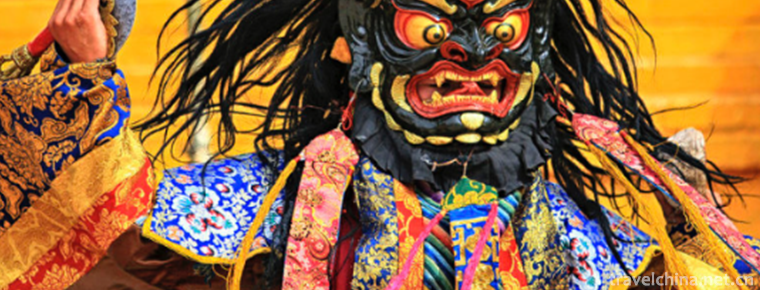
-
Juyong Pass of Great Wall of China
Juyongguan Great Wall is a famous ancient city along the Great Wall of Beijing and a national cultural relic protection unit. It is a national AAAA scenic spot assessed by Beijing Tourism Bureau.
Views: 181 Time 2018-12-10 -
Baimaiquan Park
Baimaiquan Scenic Area, located at No. 2017 Huiquan Road, Zhangqiu District, Jinan City, Shandong Province, is located in the eastern part of Jinan City. Founded in 1986.
Views: 147 Time 2019-01-02 -
Baxian longevity noodles
Make it with Udonghua noodles. With turtle, old turtle boiled soup, turtle has a nourishing role, old turtle represents longevity. Take shrimp, squid, sea cucumber, black fish balls.
Views: 173 Time 2019-03-27 -
Eight claw Fish Powder Pueraria Decoction
500 grams of Pueraria Thunb, 50 grams of octopus, 400 grams of pork legs, four candied dates, and 1/6 peel..
Views: 131 Time 2019-03-27 -
Lantern Dance
Lantern dance is a Chinese folk dance with a long history. It has been performed mainly on Lantern Festival for at least 1,000 years. Lantern dance originated from Lantern Festival and its production .
Views: 1410 Time 2019-04-26 -
Traditional cooking techniques of Liao cuisine
In April 2016, "Liao cuisine traditional cooking skills" was approved by the State Council as a national intangible cultural heritage, Liao cuisine became the first major cuisine department .
Views: 188 Time 2019-05-13 -
Ulger
Uliger, which means "storytelling" in Mongolian, is commonly known as "Mongolian Shushu", "Mongolian Shushu" and "Mongolian Qinshu". It is a form of music art t.
Views: 144 Time 2019-06-29 -
The Decorative Techniques of Yi Lacquerware
Yis lacquerware decoration technology chooses high-quality azalea, acid wood, camphor wood as raw materials, through sawing, planer, grinding, sticking and other processes, and then carefully paint th.
Views: 370 Time 2019-07-12 -
Youyang Folk Songs
Youyang folk song is a rich and colorful folk culture created and accumulated by the Tujia, Miao and Han people in Youyang Tujia and Miao Autonomous County of Chongqing in the long practice of product.
Views: 128 Time 2019-07-14 -
Chaohu University
Chaohu College (Chaohu University), located in Chaohu, Hefei, Anhui, Chaohu half soup hot spring health resort, is a Anhui provincial full-time undergraduate institutions, local application oriented i.
Views: 178 Time 2019-11-08 -
Sugar Eggs
Laozao is a local snack, belonging to Sichuan cuisine. Laolao, a kind of wine brewing in ancient Chinese, is a Sichuan dialect, that is, boiled eggs with wine brewing. Put the mash in the pot and boil.
Views: 468 Time 2020-03-09 -
About Ding Zhen picture
Zhaxi Dingzhen (Chinese Name: Ding Zhen), born in 2000, lives in Litang County, Ganzi Prefecture, Sichuan Province..
Views: 155 Time 2020-12-06

